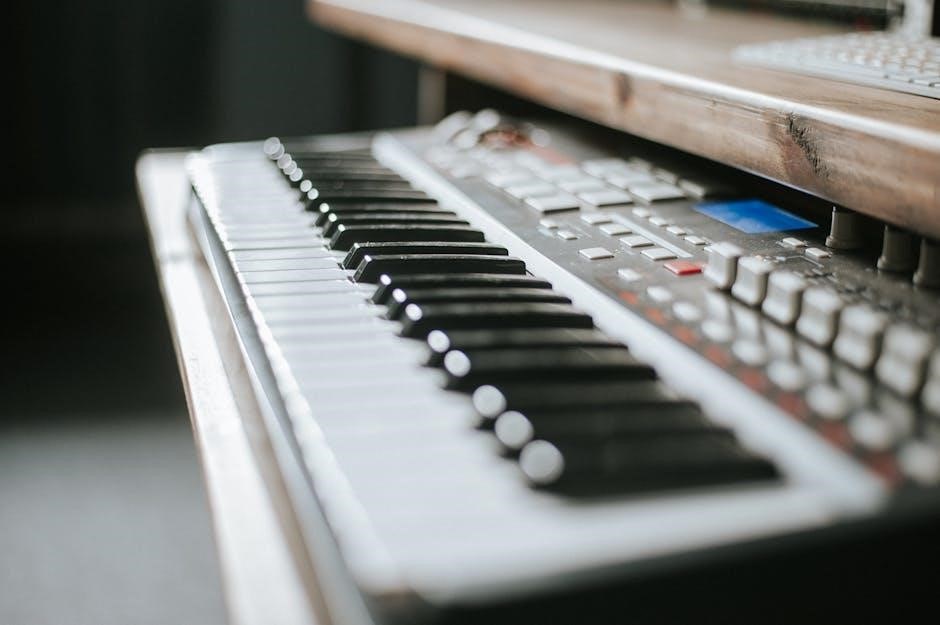
Master essential FL Studio shortcuts to enhance your music production workflow․ Learn time-saving keys for navigation, editing, and mixing․ Boost creativity and efficiency with this comprehensive guide․
Overview of FL Studio and Its Importance in Music Production
FL Studio, formerly known as FruityLoops, is one of the most popular digital audio workstations (DAWs) used by music producers worldwide․ Its user-friendly interface, powerful tools, and versatility make it a favorite among both beginners and professionals․ FL Studio excels in MIDI editing, beat-making, and audio recording, offering features like the renowned piano roll editor and a robust mixer․ Its importance lies in its ability to streamline music production, enabling creators to bring their ideas to life efficiently․ Whether for hip-hop, EDM, or other genres, FL Studio remains a cornerstone in modern music production․
Why Keyboard Shortcuts Are Essential for Efficient Workflow
Keyboard shortcuts are crucial for optimizing your workflow in FL Studio, allowing you to access tools and functions instantly․ By minimizing reliance on mouse navigation, shortcuts save time and reduce distractions, enabling you to focus on the creative process․ They streamline tasks like selecting tools, editing MIDI notes, and navigating windows, making your production process faster and more seamless․ Mastering these shortcuts enhances productivity, ensuring you can concentrate on crafting music without interruption․ This efficiency is vital for meeting deadlines and delivering high-quality results in professional music production environments․
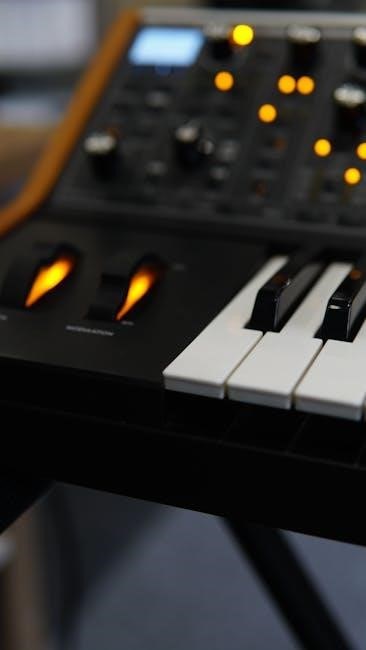
Benefits of Using FL Studio Shortcut Keys
FL Studio shortcuts boost productivity, saving time and enhancing creativity․ They streamline navigation, editing, and mixing, allowing for a smoother workflow and better focus on music production․
Time-Saving and Increased Productivity
FL Studio shortcuts significantly reduce the time spent on repetitive tasks, allowing producers to focus on creativity․ Using keys like Ctrl+S for saving projects and F5 for accessing the Playlist ensures efficient workflow․ Quick navigation between windows (e․g;, F6 for Channel Rack) and editing tools (e․g․, E for Select tool) minimizes mouse usage, speeding up the production process․ These shortcuts enable faster execution of tasks, making music creation more fluid and less tedious․ Mastering them is essential for professional and amateur producers alike․
Enhanced Creativity and Focus on Music Production
FL Studio shortcuts empower producers to maintain creative flow by minimizing interruptions․ Tools like the Paint (P) and Pencil (B) keys enable quick MIDI note editing, while features like note randomization (Alt+R) and chopping (Alt+U) spark inspiration․ These shortcuts reduce mouse dependency, allowing producers to stay focused on their artistic vision․ By streamlining tasks, creators can channel their energy into crafting unique sounds and beats, fostering a more immersive and productive music-making experience․
Streamlined Navigation and Workflow
FL Studio shortcuts simplify navigation, enabling seamless access to essential windows like the Playlist (F5), Channel Rack (F6), and Mixer (F9)․ The Browse (Alt + F8) feature streamlines file management․ Quick keys like Ctrl + T for pattern selection and F1 for help reduce workflow bottlenecks․ These shortcuts allow producers to focus on creativity, transitioning smoothly between tasks without losing momentum․ Efficient navigation ensures a more organized and productive music production process․
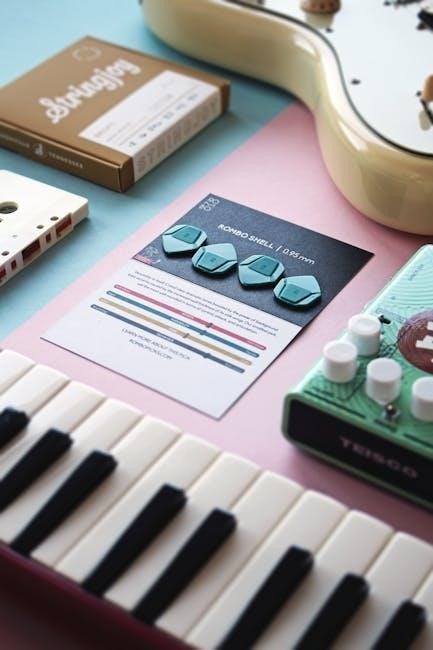
Basic FL Studio Navigation Shortcuts
Master essential navigation shortcuts to access FL Studio’s main windows efficiently․ Use F5 for Playlist, F6 for Channel Rack, F7 for Piano Roll, and F9 for Mixer․
Accessing Main Windows
In FL Studio, quick access to main windows is crucial for efficient workflow․ The F5 key opens the Playlist, where you arrange audio and MIDI clips․ Use F6 to access the Channel Rack, which houses your instruments and effects․ The F7 key launches the Piano Roll for MIDI editing, while F9 opens the Mixer for adjusting levels and effects․ Additionally, the Browser, accessible via Alt + F8, allows you to manage and browse files seamlessly․ These shortcuts ensure rapid navigation between sections, enhancing your overall productivity and creativity in FL Studio․
Channel Rack (F6), Piano Roll (F7), Mixer (F9), and Playlist (F5)
The Channel Rack (F6) is where you manage instruments and effects, while the Piano Roll (F7) is ideal for editing MIDI notes․ The Mixer (F9) allows you to adjust levels, panning, and effects for each track․ The Playlist (F5) is your workspace for arranging audio and MIDI clips․ These shortcuts enable quick access to essential tools, streamlining your workflow and allowing you to focus on creativity․ Mastering these keys will significantly enhance your efficiency in FL Studio, making your music production process smoother and more enjoyable․
Browsing and Managing Files (Alt + F8)
The Alt + F8 shortcut opens FL Studio’s Browser, a central hub for managing files, samples, and plugins․ This tool streamlines access to your assets, making production more efficient․ Use it to navigate through folders, preview samples, and quickly load presets․ Organizing your files here ensures you can find what you need without disrupting your creative flow․ A well-structured Browser enhances your workflow, allowing you to focus on making music rather than searching for sounds․
Essential FL Studio Editing Shortcuts
Master core editing commands like cut (Ctrl+X), copy (Ctrl+C), and paste (Ctrl+V) to manipulate clips efficiently․ Use undo (Ctrl+Z) and redo (Ctrl+Y) to correct mistakes instantly, ensuring a smooth workflow․
Selecting and Manipulating Audio and MIDI Clips
Selecting clips is streamlined with shortcuts like Ctrl+A (Select All) and Ctrl+D (Deselect)․ Use Shift+Click to select multiple clips in the Playlist․ For MIDI editing, press Alt+B to change note colors, enhancing visual organization․ Manipulate clips with precision using Alt+T to randomize notes or Alt+U to chop them, adding creativity to your tracks․ These commands allow efficient editing, ensuring your workflow remains fluid and focused on music production․
Cutting, Copying, and Pasting Elements
Cutting, copying, and pasting elements are fundamental actions in FL Studio․ Use Ctrl+X to cut selected elements, Ctrl+C to copy, and Ctrl+V to paste․ These shortcuts work across various windows, including the Playlist and Piano Roll․ For precise placement, use Shift+V to paste without position offset․ These commands streamline editing, allowing quick duplication and arrangement of audio and MIDI clips, enhancing your workflow efficiency and creativity in music production․
Undoing and Redoing Actions
Undoing and redoing actions in FL Studio are simple with keyboard shortcuts․ Press Ctrl+Z (Windows) or Cmd+Z (Mac) to undo the last action․ To redo, use Ctrl+Y or Ctrl+Shift+Z (Windows) and Cmd+Shift+Z (Mac)․ These shortcuts allow quick corrections without disrupting your workflow․ Undo/redo functions are context-dependent, working in the Piano Roll, Playlist, and Mixer․ They are indispensable for experimenting and refining your work efficiently, ensuring you never lose progress while tweaking your music production projects․

Transport Controls and Playback Shortcuts
Master playback controls with essential shortcuts․ Press Spacebar to start/stop playback․ Use Ctrl + L to toggle loop, and Shift + T to set markers for precise editing and navigation․
Starting and Stopping Playback
Efficiently control playback with simple shortcuts․ Press the Spacebar to start or stop playback, allowing seamless navigation․ This key is universally recognized for its functionality across all DAWs․ Additionally, use Shift + Spacebar to play the selection or clip under the cursor, ideal for previewing specific sections․ These shortcuts streamline your workflow, enabling quick auditioning and editing without interrupting your creative flow․ Mastering these basics ensures a smoother, more efficient music production process in FL Studio․
Looping Sections and Setting Markers
Efficiently loop sections and set markers to streamline your workflow․ Use the B key to toggle the loop mode, allowing you to focus on specific sections of your track․ Set markers with Alt + [Number Keys] (Windows) or Command + [Number Keys] (Mac) to create reference points․ Insert markers dynamically during playback with Shift + M․ These shortcuts enable precise editing and seamless navigation, ensuring you can work efficiently on complex projects without losing focus․ Mastering these tools enhances your productivity in FL Studio․
Adjusting Tempo and Time Signature
Easily modify tempo and time signature to refine your track’s rhythm․ Use Alt + T (Windows) or Command + T (Mac) to open the tempo settings․ Adjust the BPM directly or use the tap tempo feature for precise control․ For time signature changes, press Alt + Shift + T (Windows) or Command + Shift + T (Mac)․ These shortcuts allow quick adjustments without interrupting your workflow․ Fine-tune your project’s timing and rhythm with these essential commands, ensuring your music production stays synchronized and professional․
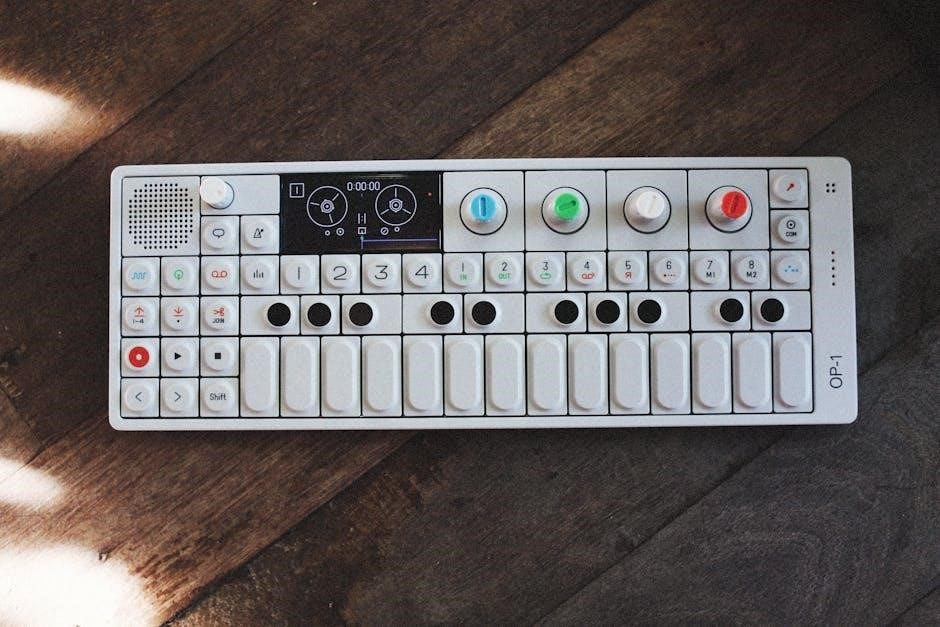
Mixing and Automation Shortcuts
Streamline your mixing process with essential shortcuts․ Mute tracks with Ctrl+M (Windows) or Command+M (Mac)․ Solo channels using Ctrl+S (Windows) or Command+S (Mac)․ Adjust levels and panning effortlessly, and automate parameters for dynamic control․ These shortcuts enhance efficiency and precision in your mixing workflow․
Muting and Soloing Channels
Muting and soloing channels are crucial for isolating sounds and refining mixes․ Use Ctrl+M (Windows) or Command+M (Mac) to mute a channel․ For soloing, press Ctrl+S (Windows) or Command+S (Mac)․ These shortcuts allow you to focus on specific tracks without affecting others․ Holding Shift while muting or soloing applies the action to all selected channels, streamlining your workflow․ This ensures precise control over your mix, enabling you to tweak levels, panning, and effects efficiently․ Mastering these shortcuts enhances your mixing accuracy and overall production quality․
Adjusting Levels and Panning
Efficiently adjust levels and panning using FL Studio shortcuts to refine your mix․ Use the mouse wheel to adjust levels on channel faders․ For panning, press Alt while moving the mouse wheel․ Quickly reset levels or panning to default by pressing Alt while clicking the parameter․ Copy and paste levels or panning settings using Ctrl+C and Ctrl+V․ Hold Shift to fine-tune adjustments․ These shortcuts streamline mixing, allowing precise control over track dynamics and spatial placement in your productions․
Recording and Editing Automation
Streamline automation in FL Studio with essential shortcuts․ Enable automation recording with Alt + A․ Start recording by pressing Space or F6․ Toggle automation view using Alt + V․ Edit automation clips by selecting them with Left-Click and adjusting with Right-Click menu options․ Delete unwanted automation by pressing Del․ Use Ctrl + C and Ctrl + V to copy and paste automation․ Hold Shift to fine-tune automation points․ These shortcuts simplify automation editing, allowing precise control over track dynamics and effects in your projects․

MIDI Editing and Pattern Shortcuts
Enhance MIDI editing efficiency with dedicated shortcuts․ Use Alt + A to randomize notes and Alt + U to chop them․ Select notes with Shift + Click and extend with Alt + L․ Edit patterns seamlessly with Ctrl + T for selection and Space to start playback․ These tools accelerate MIDI manipulation, ensuring precise control over your compositions․
Selecting and Editing MIDI Notes
Efficiently edit MIDI notes with essential shortcuts․ Use Shift + Click to select multiple notes and Alt + A to randomize them․ Chop notes with Alt + U and extend with Alt + L․ Select all notes using Ctrl + A (Windows) or Cmd + A (Mac)․ Invert selections with Ctrl + I (Windows) or Cmd + I (Mac)․ Delete notes with Del or Backspace․ Use Ctrl + T to select patterns and Space to start playback․ These shortcuts streamline MIDI editing, allowing precise control over your compositions․ Mastering them enhances your workflow and creativity in FL Studio․
Using the Paint and Pencil Tools
The Paint and Pencil tools are indispensable for creating and refining MIDI notes․ Press P to activate the Paint tool, which allows you to draw notes freely․ Use N for the Pencil tool, ideal for precise note placement․ Hold Alt while painting or drawing to add notes to existing ones․ Shift + P toggles between Paint and Pencil modes․ These tools enable quick and intuitive MIDI editing, helping you craft and refine musical ideas with ease․ Mastering them enhances your workflow and creativity in FL Studio․
Randomizing and Chopping MIDI Notes
Enhance your MIDI editing with randomization and chopping tools․ Press Alt + R to randomize note properties like pitch and velocity․ Use Shift + M to randomly select MIDI notes for creative variations․ For chopping, press Alt + U to slice notes into smaller segments․ Alt + L extends notes to fill gaps․ These shortcuts add uniqueness and complexity to your tracks, making your music production more dynamic and engaging․ Mastering these techniques allows for limitless creativity in shaping your MIDI patterns․

Creating a PDF of FL Studio Shortcuts
A PDF of FL Studio shortcuts offers quick reference, offline access, and printing convenience․ It’s ad-free and organizes shortcuts neatly for efficient workflow․
Why a PDF Format is Useful
The PDF format is ideal for FL Studio shortcuts due to its portability and consistent formatting across devices․ It allows for offline access, easy printing, and ad-free viewing, making it a practical tool for quick reference․ PDFs maintain layout integrity, ensuring shortcuts are neatly organized and searchable, which is essential for efficient workflow․ This format is universally compatible with both Windows and macOS, catering to all FL Studio users․ Its versatility and accessibility make it an excellent choice for mastering shortcuts and enhancing productivity in music production․
Printing and Offline Access
Printing FL Studio shortcuts in PDF format ensures you have a physical reference, ideal for studio use․ Offline access allows you to view shortcuts without internet, making it convenient during production sessions․ The PDF’s clean layout, free from ads, enhances readability․ This feature is particularly useful for producers working in environments with limited connectivity or those who prefer tactile learning tools․ Having a printed or offline copy simplifies workflow, enabling quick access to essential commands anytime, anywhere․
Organizing Shortcuts for Quick Reference
A PDF of FL Studio shortcuts allows for easy organization, making commands accessible at a glance․ Categorizing shortcuts by function—such as navigation, editing, or mixing—streamlines workflow․ Users can further customize the layout, highlighting frequently used keys or grouping related actions together․ This structured approach reduces time spent searching for commands, enabling producers to focus on creativity․ Additionally, the ability to print or save the PDF ensures that essential shortcuts are always within reach, even in fast-paced production environments․
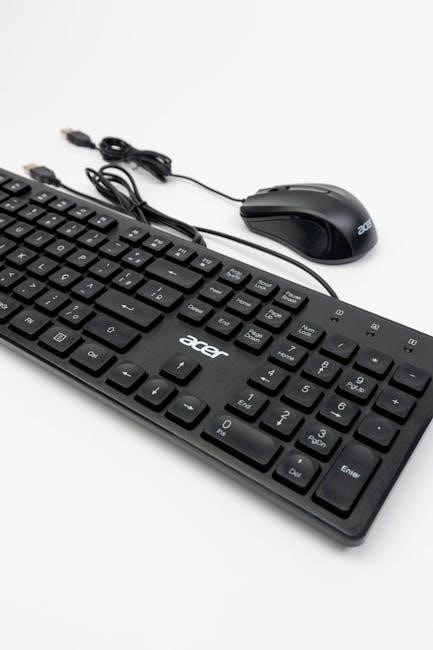
Advanced FL Studio Shortcuts
Unlock advanced MIDI editing tools, plugin hotkeys, and workflow customization options to elevate your production skills and streamline complex tasks efficiently․
Shortcuts for Advanced MIDI Editing
Master advanced MIDI editing with shortcuts like ALT + R to randomize notes, ALT + U to chop notes, and SHIFT + M to randomly select notes․ These tools allow for precise control over MIDI data, enabling quick experimentation and complex pattern creation․ Use ALT + L to extend notes and CTRL + A to select all notes for efficient editing․ These shortcuts streamline your workflow, allowing you to focus on creativity while handling intricate MIDI manipulations effortlessly in FL Studio․
Using Hotkeys for Plugins and Effects
Efficiently manage plugins and effects using hotkeys to enhance your workflow․ Use CTRL + F to search for plugins quickly, and CTRL + E to enable/disable effects․ Assign custom shortcuts to frequently used plugins via the MIDI controller or keyboard․ This allows seamless integration of effects like reverb, delay, and compression․ Utilize these hotkeys to navigate and adjust parameters without leaving your creative flow, ensuring a smooth and efficient production process in FL Studio․
Customizing Your Workflow with Shortcuts
Tailor FL Studio to your workflow by assigning custom shortcuts․ Use the MIDI controller or keyboard to create personalized key bindings․ CTRL + ALT + S allows you to save custom settings, ensuring your unique workflow is preserved․ This customization enhances efficiency, enabling faster access to frequently used tools and effects․ By streamlining your setup, you can focus more on creativity and less on navigating menus․ Experiment with different configurations to find what works best for your production style․

Customizing FL Studio Shortcuts
FL Studio allows users to create personalized shortcuts, enhancing workflow efficiency․ Assign custom key bindings to frequently used tools and effects․ Export and import settings for easy access․
Assigning Custom Key Bindings
In FL Studio, users can assign custom key bindings to tailor their workflow to personal preferences․ Access the shortcut settings via the Options menu․ Select actions from the extensive list and assign preferred keys․ This feature allows for personalized efficiency, enabling quick access to frequently used tools and functions․ Custom bindings can be saved and exported, ensuring consistency across projects․ Experiment with different configurations to optimize your creative process and enhance productivity․ This customization capability makes FL Studio highly adaptable to individual production styles and needs․
Creating a Personalized Shortcut Layout
Designing a personalized shortcut layout in FL Studio streamlines your workflow and boosts efficiency․ Start by identifying frequently used functions and mapping them to easily accessible keys․ Use the Custom Shortcut feature under the Options menu to assign unique key combinations․ Organize shortcuts by categorizing them into groups, such as editing, mixing, or navigation․ This tailored approach reduces mouse dependency and allows for a more intuitive production process․ Regularly review and update your layout to adapt to evolving project demands, ensuring optimal productivity and creativity in your music production journey․
Exporting and Importing Shortcut Settings
FL Studio allows users to export and import custom shortcut settings, ensuring consistency across different setups․ This feature is particularly useful for producers working on multiple devices or collaborating with others․ By exporting your shortcut layout, you can easily transfer your preferred key bindings to another installation of FL Studio․ Importing settings enables quick adoption of predefined configurations, saving time and maintaining workflow continuity․ This functionality is ideal for professionals who rely on specific shortcuts for efficiency and creativity in their music production environment․

Common Mistakes to Avoid When Using Shortcuts
Avoiding common errors ensures smooth workflow․ Overlooking context-dependent shortcuts and ignoring default bindings can lead to conflicts․ Troubleshoot issues promptly to maintain efficiency and focus in FL Studio․
Context-Dependent Shortcuts
Context-dependent shortcuts in FL Studio change functionality based on the active window or tool․ For instance, the same key might trigger different actions in the Piano Roll versus the Mixer․ Understanding these dependencies is crucial to avoid confusion․ For example, Ctrl + T opens the Pattern Selector in the main window but serves a different purpose in other contexts․ Always verify the current workspace to ensure shortcuts behave as expected, enhancing workflow efficiency and reducing errors․ Proper use of context-dependent keys streamlines operations, allowing producers to focus on creativity rather than navigation challenges․ Utilizing these shortcuts effectively can significantly improve productivity and overall user experience․
Avoiding Conflicts with Default Key Bindings
Avoiding conflicts with default key bindings is essential for a smooth FL Studio experience․ Custom shortcuts should not overlap with predefined keys to prevent unexpected behavior․ For example, Ctrl + T is reserved for the Pattern Selector, so assigning it elsewhere can cause issues․ Always review existing bindings before customization․ Use FL Studio’s shortcut management tools to identify and resolve conflicts․ This ensures that your workflow remains uninterrupted and all functions operate as intended․ Properly managing key bindings enhances productivity and reduces frustration during music production sessions․ Regularly auditing shortcuts helps maintain a conflict-free environment․
Troubleshooting Shortcut Issues
Encountering issues with FL Studio shortcuts? Start by checking if the key bindings are correctly assigned in the shortcut settings․ Often, conflicts or overlapping bindings cause commands to malfunction․ Resetting to default shortcuts can resolve many problems․ Additionally, ensure that shortcuts are context-appropriate, as some keys function differently depending on the active window․ Regularly updating FL Studio and reviewing its documentation can also address bugs or compatibility issues․ Troubleshooting shortcuts is crucial for maintaining a seamless and efficient music production workflow․
Mastering FL Studio shortcuts unlocks professional-grade music production․ By streamlining your workflow, you enhance creativity and efficiency, ensuring your projects stand out in the industry․
Mastering FL Studio Shortcuts for Professional Results
Mastering FL Studio shortcuts is crucial for achieving professional results in music production․ By memorizing key commands, producers can work faster and focus on creativity․ Essential shortcuts for the Piano Roll, transport controls, and MIDI editing streamline tasks like note manipulation and pattern creation․ Regular practice and customization of shortcuts ensure a tailored workflow, enhancing efficiency․ As professionals rely on these tools, mastering them becomes indispensable for delivering high-quality projects․ Dedication to learning shortcuts elevates production skills, making FL Studio a powerful instrument for artistic expression․
Continuous Learning and Improvement
Continuous learning is key to mastering FL Studio shortcuts․ Regularly updating your knowledge ensures you stay efficient with new features and tools․ Exploring the official FL Studio shortcut PDF and online resources provides a wealth of insights․ Engaging with tutorials, forums, and producer communities helps discover hidden gems․ Practice shortcuts consistently to build muscle memory․ Over time, this fosters a smoother workflow, allowing you to focus on creativity․ Embrace lifelong learning to unlock FL Studio’s full potential and remain competitive in music production․
Sharing and Discovering New Shortcuts
Sharing and discovering new FL Studio shortcuts fosters growth and efficiency․ Producers often exchange tips in forums and social media, revealing hidden gems․ The FL Studio shortcut PDF is a valuable resource, compiling essential keys for quick reference․ Exploring these shortcuts can enhance your workflow and creativity․ Engage with online communities to learn from others and share your own discoveries․ This collaborative approach ensures you stay updated with the latest techniques, making your production process smoother and more enjoyable․ Embrace the power of shared knowledge to elevate your music-making skills․